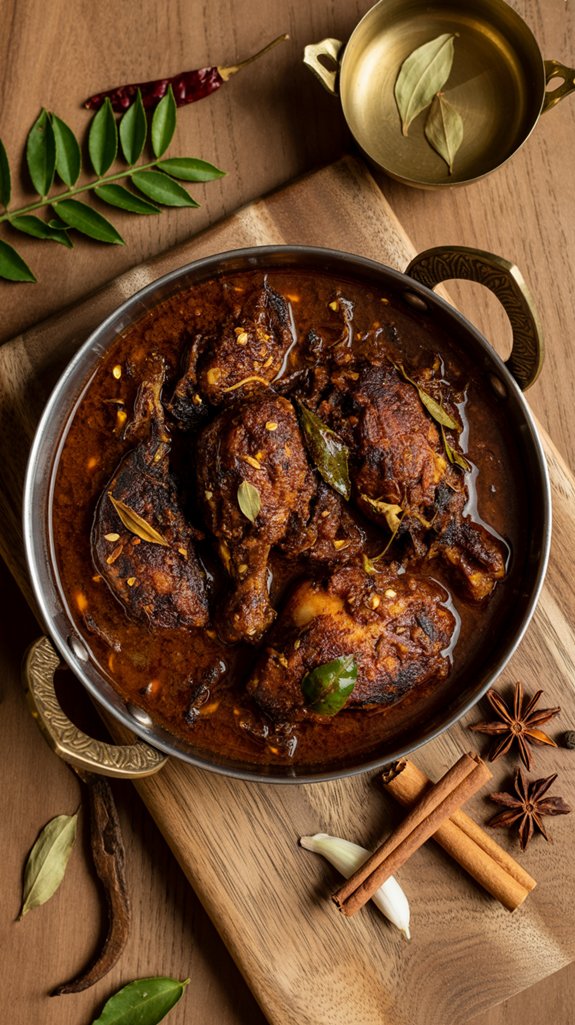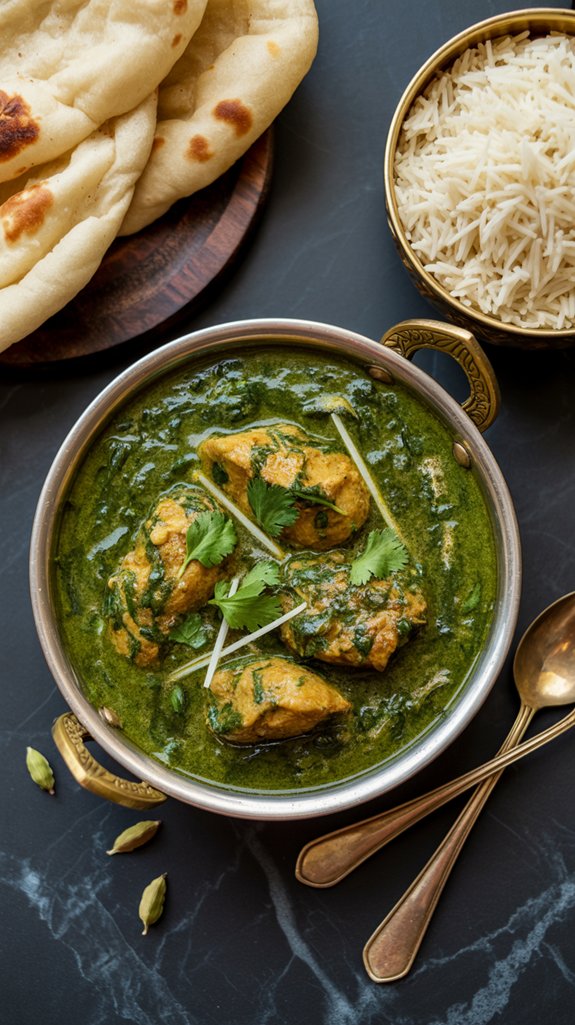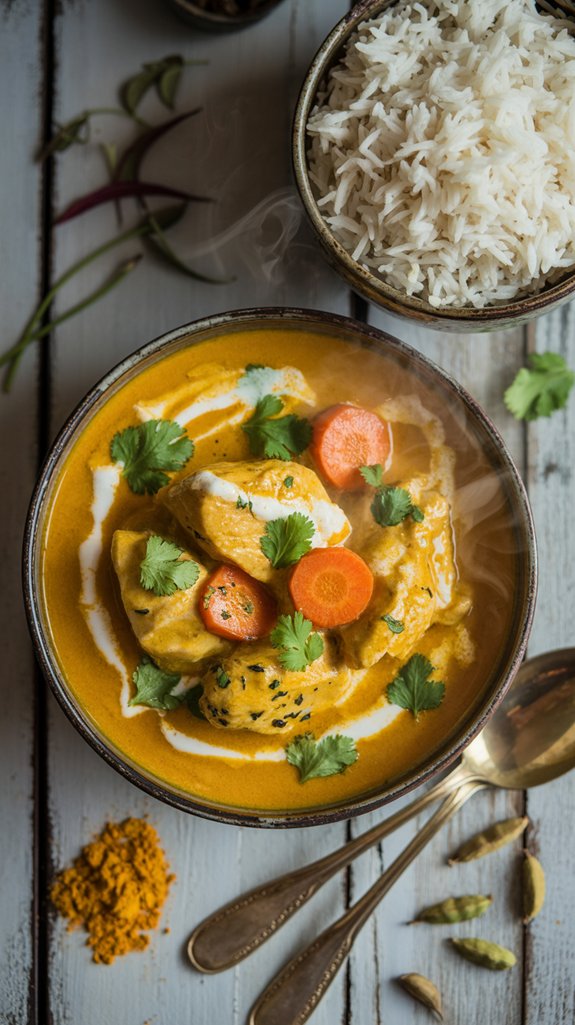Why You’ll Love This this Spicy South Indian Chicken Chettinad
This aromatic chicken dish brings together a symphony of whole spices, curry leaves, and dried chilies that’ll fill your kitchen with the most incredible fragrance you can imagine.
The beauty of Chettinad cooking lies in that essential roasting step, where coconut, spices, and aromatics get toasted until they release their oils and deepen into something absolutely magical.
You get tender chicken swimming in a rich, complex gravy that’s got layers of flavor from the tamarind’s tang, the warmth of freshly ground spices, and that distinctive South Indian flair that makes every bite feel like a little celebration.
Ingredients List
This Chicken Chettinad recipe calls for a beautiful collection of whole spices and aromatics that’ll transform your kitchen into a South Indian spice market.
- 1 whole chicken
- 4 dried red chilies, broken by hand into pieces
- 1 1/2 tablespoons grated fresh ginger
- 1 1/2 tablespoons garlic
- 2 tablespoons dry grated coconut (khopra) or fresh coconut
- 2 teaspoons mixed whole spices (cardamom, peppercorns, cloves, and cinnamon)
- 1 tablespoon whole coriander seeds
- 1 walnut-sized ball of tamarind, soaked in water
- 1/2 cup fresh curry leaves
- 2 tablespoons ground coriander powder
- 4 medium onions, sliced
- 2 tablespoons oil
- Salt to taste
- Fresh coriander leaves for garnish
Health Considerations:
- This recipe packs serious antioxidant power from turmeric, ginger, garlic, and those gorgeous whole spices that fight inflammation
- Tamarind adds vitamin C and supports digestion, while curry leaves bring iron and calcium to the party
- The coconut provides healthy fats, though you can reduce the oil if you’re watching calories
- All those spices mean you’re getting flavor without relying on excess salt or sugar
Step by Step Directions

This aromatic South Indian curry builds layers of complex flavors through careful roasting and timing of spices.
- Prepare the base: Heat oil in a wok or large frying pan over medium heat.
- Toast the aromatics: Add coconut, broken red chili pieces, coriander seeds, whole spices (cardamom, peppercorns, cloves, cinnamon), and curry leaves to the hot oil, roasting until fragrant.
- Build the foundation: Add sliced onions to the pan and fry until golden brown and caramelized.
- Add the paste ingredients: Stir in grated ginger and garlic, cooking for 5 minutes until the raw smell disappears.
- Incorporate wet ingredients: Add the soaked tamarind pulp (strained), chicken pieces, salt, and ground coriander powder.
- Create the gravy: Add 1/2 cup water if you prefer a thicker gravy consistency.
- Initial cooking: Cook exposed for 10 minutes, stirring occasionally to prevent sticking.
- Final cooking: Cover the pan and continue cooking until the chicken is fully cooked and tender, approximately 15-20 minutes.
- Finish and serve: Garnish with fresh coriander leaves before serving hot with rice or Indian bread.
Using a high-quality premium indian cookware set ensures even heat distribution and prevents sticking for optimal curry preparation.
Substitutions and Variations
- Coconut milk variation – replace half the water with coconut milk for a richer, South Indian coastal twist that’s absolutely divine.
- Vegetarian version – swap the chicken for cauliflower, potatoes, or paneer, though you’ll need to adjust cooking times since vegetables don’t need as long to get tender.
- No curry leaves? This one hurts a little since they’re so essential to authentic Chettinad flavor, but bay leaves can pinch-hit in a crisis – use about 3-4 leaves.
- Bone-in versus boneless chicken – bone-in gives you more flavor and stays juicier, but boneless cooks faster if you’re in a rush.
Additional Things to Serve With This Dish
This spicy, aromatic dish practically begs for the right companions to balance out all that heat and bold flavor.
- Steamed basmati rice – the classic choice that soaks up every drop of that incredible gravy, and honestly, anything else feels like you’re missing the point.
- South Indian breads – naan works fine, but if you can find appam or dosa, you’re in for a real treat with those crispy edges and soft centers.
- Cooling yogurt dishes – raita with cucumber and mint will be your best friend when the spice hits, or even plain yogurt mixed with a pinch of salt.
- Simple vegetable sides – roasted okra, sautéed spinach, or dal keeps things authentic without competing with the star of the show.
- Pickled vegetables – a small serving of Indian pickles or even quick-pickled onions cuts through the richness beautifully.
- Fresh herbs and garnishes – extra cilantro, sliced green chilies for the brave souls, and maybe some fresh lime wedges for that bright pop of acid.
Cooking Tips & Tricks (Chef’s Notes)
Getting this dish right comes down to a few key moves that’ll save you from any kitchen disasters.
- Toast those spices like your life depends on it – seriously, the difference between properly roasted and half-hearted spices is what separates restaurant-quality from meh, so keep stirring until that coconut turns golden and everything smells incredible.
- Don’t rush the onions – I know, I know, browning onions feels like it takes forever, but those caramelized bits are where all the deep, sweet flavor hides, so give them the time they deserve.
- Fresh curry leaves or bust – dried ones work in a pinch, but fresh curry leaves give you that authentic pop of flavor that makes people wonder what your secret is.
- Tamarind soaking trick – break up that walnut-sized ball in warm water for at least 15 minutes, then really mash it with your fingers to get all the pulp out before straining.
- Water control is everything – start with less liquid than you think you need because you can always add more, but trying to reduce a watery gravy while your chicken overcooks is just asking for trouble.
- Taste as you go – this dish should build layers of flavor, so adjust that salt and spice level throughout the cooking process instead of hoping it all works out at the end.
- Let it rest – give the finished dish 10 minutes to sit before serving, which lets all those bold flavors meld together into something magical.
Nutritional Facts
This powerhouse dish packs serious nutrition alongside its bold flavors.
- High-quality protein – one serving delivers approximately 25-30 grams of complete protein from chicken, supporting muscle health and keeping you satisfied.
- Heart-healthy spices – turmeric, coriander, and black pepper contain anti-inflammatory compounds that may help reduce cardiovascular disease risk.
- Metabolism boosters – the combination of ginger, garlic, and red chilies can temporarily increase your metabolic rate and aid digestion.
- Antioxidant rich – curry leaves, coconut, and whole spices provide powerful antioxidants that help fight cellular damage.
- Low carb friendly – contains only 8-12 grams of carbs per serving, making it suitable for keto and low-carb diets.
- Essential minerals – good source of iron from chicken and spices, plus potassium from coconut and tamarind.
- Vitamin powerhouse – provides B-vitamins from chicken, vitamin C from fresh ingredients, and vitamin E from coconut.
- Moderate calories – approximately 280-320 calories per serving depending on oil usage and portion size.
- Natural probiotics – tamarind supports gut health with beneficial acids and fiber.
- Blood sugar friendly – the protein and spice combination helps stabilize blood glucose levels better than high-carb meals.
Fun “Did You Know?”
Ever wondered why Chicken Chettinad tastes so distinctively different from other Indian curries? I’ll share some fascinating facts!
This dish originated from the Chettinad region of Tamil Nadu, where wealthy merchants spared no expense on exotic spices. The Chettiars used over 20 different spices in their cooking, making it one of India’s most complex cuisines.
Here’s what’s interesting: traditionally, they’d grind spices on stone surfaces, which released more essential oils than modern grinders.
The curry leaves aren’t just garnish—they’re actually packed with antioxidants and add that signature aromatic punch you can’t replicate with substitutes.





